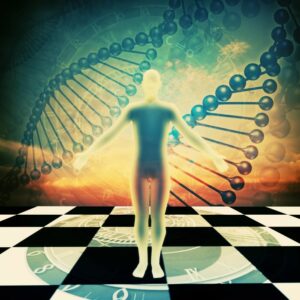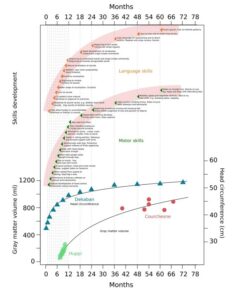Dekel Taliaz
May, 2020//
Artificial Intelligence (AI) is the key to unlocking the door to Personalized Medicine. AI enables us to go beyond genetic analysis and include vast amounts of environmental factors to personalize treatment to our life experience! Let me explain more.
 Michael Phelps is the most successful and most decorated Olympian of all time, with a total of 28 medals, of which 23 are gold medals! But what sets him apart?
Michael Phelps is the most successful and most decorated Olympian of all time, with a total of 28 medals, of which 23 are gold medals! But what sets him apart?
Some would say his genetic makeup. He is extremely tall with a thin physique, a protruding chin and disproportionately long arms – all great attributes to be an Olympic swimmer. Yet, this is only one part of the story. His environmental life experience – swim training from a young age, hard work, family support, etc. – have all played as relevant a role in his success.
The same can be said when considering personalized medicine.
When we decide on which is the right treatment to prescribe to an individual, genetics is one part of the equation – yet, we must also understand the patient’s environment and its role on our health.
The environment and the gene-driven AI solution
AI-driven genetic tests are making a change for the better (as reviewed in my previous article). Yet; AI enables us to go even further. To look at more relevant data, outside our body, to personalize a therapy. In essence, we may all be dealt a certain deck of cards – our genes, but our environment can dramatically influence our outcomes.
In terms of mental health disorders, it is becoming clear through research, that AI and Big Data, can help us delve deeper into understanding the genetic complexities of our psychiatric disorder. We can now in certain health conditions, such as breast cancer, understand whether someone has a genetic predisposition, an increased likelihood of developing a particular disease based on a person’s genetic makeup.
However, in the case of depression, as discussed in my previous post, the story is much more complex. The search for a single gene responsible for major depressive disorder has given way to the understanding that depression is a complex disorder in which multiple gene variants, each having only a slight contribution to the disorder, are involved. The explanation to the variation in treatment efficacy of the different anti-depressants is probably linked with a patient’s genetic background. However, to form a relevant and accurate picture we must also understand their environment.
Here’s why?
The role of the environment and our genetic predisposition for mental illness
A genetic predisposition results from specific genetic variations that are often inherited from a parent. These genetic changes contribute to the development of a disease but do not directly cause it. Some people with a predisposing genetic variation will never get the disease while others will, even within the same family. The prevailing theory is that some people are genetically predisposed to mental illness, which are provoked by environmental factors.
Furthermore, the timing of these environmental factors can have a profound effect on our health outcomes. See the figure below combining data from different studies measuring gray matter and head circumference increases, with the normal development of human skills as described in child development text books. Data was taken from Dekaban, 1977; Huppi et al., 1998; Courchesne et al., 2000 and Holt, 1991.

Early childhood is an extremely sensitive period in brain development, especially the circuitry governing emotion, attention, self-control and stress, is shaped by the interplay of a child’s genes and experiences. As children grow, the biological and environmental factors that determine their development become increasingly intertwined. The impact of poverty, inappropriate care or violence for example, in our environment during these sensitive periods, may route children on a course to emotional, physical and mental health problems[i].
Therefore, comprehending the role of our environment, in essence how our environment and the individual lifestyle we lead interacts with our genome, is critical to understanding mental illness. Just because we are genetically programmed a certain way, does not mean our body will choose to run that genetic program. Our environment can determine gene expression and as a result, determine our predisposition for a psychiatric disorder. A good example can be seen in research by McGowan et al (2009)[ii], where the environmental experience of childhood abuse may lead to specific epigenetic changes, which could affect the hypothalamic-pituitary-adrenal (HPA) stress responses, and may increase the behavioral risk of suicide!
Clearly, to personalize medicine and predict which treatment is the most effective for each individual, we must understand our genetic makeup in combination with the environmental factors influencing our genetic journey.
Using AI to crack our genetic and environmental complexities
Artificial Intelligence (AI) algorithms and Big Data provide us with an opportunity to understand the role of genetic and environmental complexities in personalized medicine.
To understand that a patient is more than genetics, and instead consider the complete environmental picture that influences a patient – for example our clinical, demographic, social and economic journey. Only by reflecting and understanding a patient’s complete life experience, can we truly deliver personalized treatment.
This scientific-holistic approach is exactly the Taliaz mindset and it is the basis for the AI models driving the Predictix platform. Using our AI prediction algorithm, Predictix, we can go beyond traditional genetic biomarker testing to analyze the great number of genetic and environmental combinations affecting patient’s health conditions.
Revealing the Taliaz AI Predictix logic and technology
As I described in an earlier blog, explaining how we use AI to make sense of genetic complexities, we take a similar approach to discovering the important environmental features for our AI model. In the case of depression, we use available research and proprietary models to help us understand what are the key environmental features.
We analyze thousands of clinical features and their interconnectedness. For example, one clinical feature may actually be a plurality of 10 clinical features, comprising severity level problems in the upper gastro-intestine, reported fear of having an anxiety attack, having a history of psychotropic medications, and so on.
We can also incorporate huge amounts of personal and demographic information and combinations. Such as employment status, age, marital status, etc.
We in essence aim to collect as much environmental and genetic Big Data as we can.
We then ‘feed’ our algorithm the best subset of these integrated features, based on our research and proprietary models, that are the most important predictors to achieve our desired outcome. Our AI algorithm then learns from each piece of data, and rapidly re-evaluates its analysis as more and more data is received to optimize our prediction algorithm.
Meaning, in the case of Predictix Antidepressants, our doctors now have a better understanding of choosing the most effective antidepressant for their patients sooner.
So how do we do this?
In practice, it involves a very user-friendly, non-invasive procedure that in addition to genetic sequencing, patients respond to a short, designated questionnaire. Taliaz then uses our AI technology and deep clinical and genetic understanding to transform this data into practical decision support tools, that empower doctors to prescribe the right treatment for their patients sooner.
The future of personalized medicine: Analyzing our life experience
We are entering into a world where soon we will be able to capture any medicines anyone has ever taken, information of every doctor’s visit, our operational history and more… In other words, much of our healthcare journey will be completely online.
Furthermore, new technologies will enable this information to be shared in real time across a group of people or institutions, in a safe and secure way. Meaning we will be able to access and share this data even more easily
And let’s not forget social media and other data channels. We are now able to capture data on people’s social and work life, like never before, through Facebook and Linkedin.
Data is growing while becoming more freely accessible. And within this endless stream of data and its combinations could be the key to enabling doctors to unlock the right treatment for our specific health condition ̶ that is not just matched to our genetic profile ̶ but instead to our life experience.
Simply put, data is ushering in the era of personalized healthcare. Fasten your seatbelts, we are just getting started and the journey is going to be amazing!
————————————————————————————————————–
[ii] McGowan PO et al. (2009) Epigenetic regulation of the glucocorticoid receptor in human brain associates with childhood abuse. Nature Neuroscience 12:342–348.
